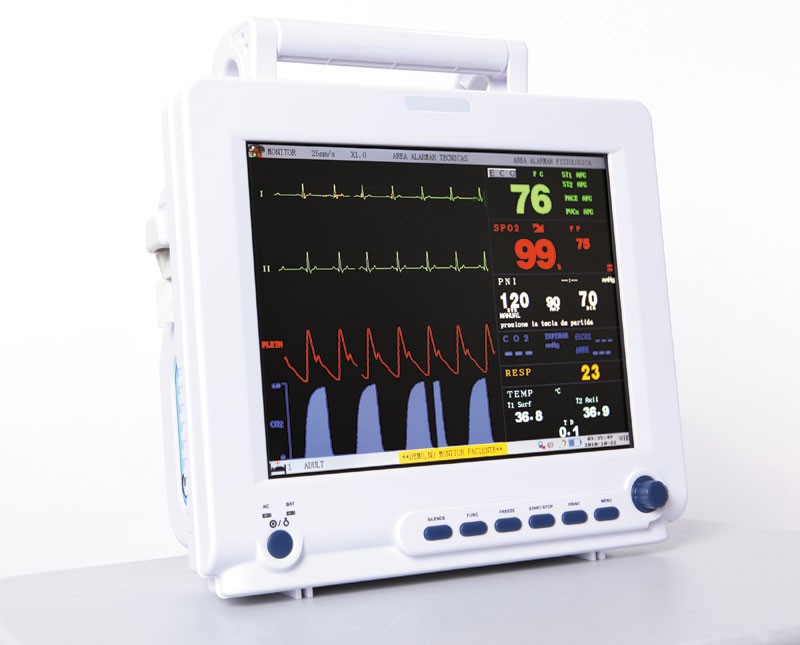A New Lifeline
You can tell a lot from an ECG. Those up-and-down lines — waves, intervals and segments — reveal the secrets of your heart. The electrocardiogram can detect the effect of a pacemaker or highlight the impact of drugs. It can show the rhythm and the rate, detecting irregularities and abnormalities. It can even indicate the size of your heart.
And, perhaps most importantly, it can show a heart attack. During a heart attack, time is everything. With each passing moment of restricted blood supply, the heart muscle is damaged. That’s why the sooner treatment starts, the better.
“You can recover faster. You can have a more meaningful life and a more normal life,” says Adam Richards, director of emergency services at the Deaconess ER. “Every minute counts.”
Fortunately, Richards says, new technology allows ECG readings to be beamed directly from the ambulance to the emergency room. As technicians on-board use a defibrillator, the device records six seconds of ECG readings. All they need to do is press a button and the information travels the same way a texted picture on an iPhone does.
At Deaconess, the ECG reading arrives simultaneously on five different computers — including an overhead monitor waiting doctors can see. It also arrives in Adam Richards’ email inbox.
So as the ambulance speeds to the hospital, the team at Deaconess can begin preparing. They can ready medication and set up the catheter lab to target and treat a blockage.
Emergency rooms are always looking for new efficiencies, ways to improve their door-to-cath lab time, Richards says.
“It’s really made big impact in just six weeks,” Richards says of having those ECGs beamed over. He estimates door-to-cath lab time was “probably reduced by about 10 to 15 minutes.”
Lo-Cal, Not Lo-Alcohol
Past those few years of reckless college experimentation, the savvy drinker knows her limits. She knows precisely how much she can drink without overindulging. She knows how long after a beer she’ll have to wait before it’s safe to drive.
But occasionally, no matter how experienced the drinker, certain drinks can turn everything topsy-turvy. That was the problem with caffeinated alcoholic drinks like Four Loko — the stimulating effects of the caffeine overwhelmed the drinker’s ability to judge precisely how drunk they really were.
Now studies have pointed to dangers of a more subtle kind: diet alcoholic drinks, for example a rum and Diet Coke.
Most people know that it’s a good idea to eat while drinking: The digestion of the food helps decrease the impact of the alcohol. But people forget that a beer has calories, too — drinking a single dark beer can be like eating three pieces of bread. Artificially sweetened diet alcoholic drinks, however, don’t have those calories.
A study from the department of medicine at the University of Adelaide in Australia tested eight men with a regular orange-flavored vodka and a nearly identical but artificially sweetened orange-flavored vodka. The artificially sweetened drink got the men drunker, and did it more quickly.
“If there’s no other calorie source in the drink… it could possibly cause them to be intoxicated faster. It would be like drinking alcohol straight,” says Jen Ropp, a dietician for Rockwood Clinic. “It’s not enough for your tummy to work on.”
Fortunately, she says there’s a simple solution to this problem. “Just don’t drink on an empty stomach.”
Big Whoop
The coughing continues. Back in 2009, there were warnings of a whooping cough problem. Washington state had an upswing in the numbers of cases — and the malady tends to come in cycles. But they didn’t expect an epidemic this bad.
“This particular epidemic is the worst we’ve had for over 40 years,” says Spokane Regional Health District Health Officer Joel McCullough.
By April, whooping cough — or “pertussis” — cases in the state of Washington had risen to epidemic levels. By June, according to the Centers for Disease Control, the year’s total had reached 2,520 confirmed cases, more than a 13,000 percent increase from the same period the year before.
In Spokane County, fortunately, it hasn’t been as bad as on the west side of the state. Yet in mid-August, rates were climbing, with 164 cases, including 18 new cases in one week. Nine had been hospitalized.
Though vaccination rates have improved to 81 percent for kids 0-6 years old, thanks to new legislation changing the “opt-out” process, low vaccination rates continue to plague Spokane — just 20 percent of adults have been vaccinated, and 30 percent of 7-18 year olds.
“We haven’t even distributed the vaccine we have,” McCullough says.
Yet roughly half of those infected had fully up-to-date vaccinations. In 2006, the vaccine changed, McCullough explains. It went from being composed of “whole-cell” viruses ground up, to an “acellular” version that just has parts of the viruses. The acellular version had an advantage of carrying fewer side effects. But it may also be somewhat less effective.
In the meantime, if your child won’t stop coughing, seek out your health care provider. And let them take a few days off from school, he says.
Before the pertussis vaccine, approximately 4,000 people died in the U.S. from the disease each year.





















